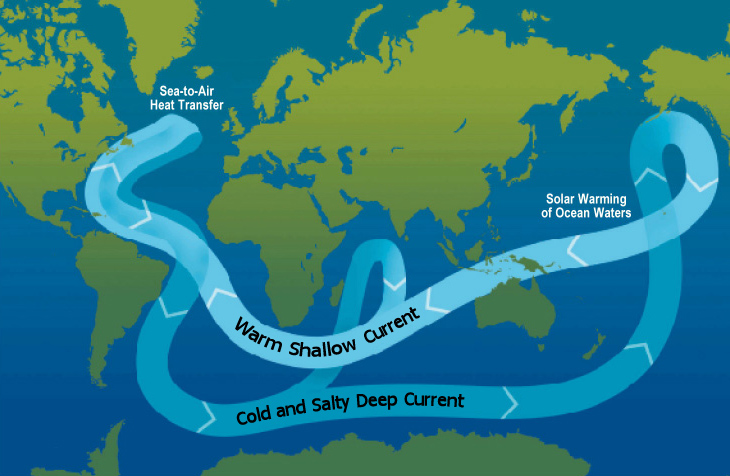
What Is The Thermohaline Circulation?
Our Planet’s Health In Motion
Our oceans are forever in motion, transporting nutrients and thermal energy across the globe. The thermohaline circulation, sometimes called the Ocean Conveyor Belt, is a vast and complex interconnected system that facilitates this motion through differences in water density. The thermohaline circulation helps to maintain a stable climate and plays an important role in the absorption of greenhouse gases from the atmosphere.
Thermohaline Mechanisms
While winds effect the upper 100 metres of the oceans surfaces, changes in water density due to salinity (salt concentration) and temperature affect deeper ocean currents. The theory of thermohaline circulation was first proposed by Henry Stommel and Arnold Arons in 1960 and is an extremely slow process – the circulating water moves at approximately 1cm per second and takes 500 years to complete a full cycle.
In warmer climates near the pacific equator, surface water is heated by the sun and flows west through the Indian ocean, southern Africa and up towards the North Atlantic via the Gulf Stream. As the warm water reaches Greenland and Norway, the effects of evaporation, heat loss and the formation of ice increases the level of salination in the water. This increases its density, causing it to sink to the ocean floor as ‘North Atlantic Deep Water’. This effect forces displaced nutrient rich water south towards Antartica and then eastwards as part of the Antartic Circumpolar Current. As it passes back into the Pacific, it starts to mix with warmer water which causes an upwelling, completing the THC cycle.
Thermohaline Circulation And Its Importance
The thermohaline circulation plays an important role in the stabilisation of the Earth’s temperature by supplying heat from the equator to the polar regions. This helps cool down the hotter regions and regulates the rate of polar sea ice formation. Changes in oceanic temperature influences global weather patterns; the gulf stream for example causes the climate of Western Europe to be milder than other regions of similar latitude.
The thermohaline circulation supports marine life and biodiversity where nutrient-rich deep water upwelling promotes the growth of plankton – the foundation energy source for the oceanic food web. The cycle also helps to lock away greenhouse gases such as carbon dioxide into the depths of the ocean, helping to mitigate the effects of global warming.
Thermohaline Circulation Slowdown
There is a growing concern for the health of the thermohaline circulation system. Global warming has led to the warming of the oceans waters and melting of the polar ice caps, the latter leading to a decreased level of salination in the polar regions. These effects make it more difficult for the formation of North Atlantic Deep Water, leading to a slowdown in the thermohaline cycle. Scientist research has suggested that if carbon emission remain constant, the thermohaline circulation will slow down by more than 40% over the next 30 years.
A collapse in this oceanic system will lead to lower levels of marine life, increased weather and global climate instability, changes in sea levels and flooding and depletion of fish stocks. Past disruptions have been attributed to the glacial conditions of the Younger Dryas event, around 12,000 years ago. We must therefore take care to ensure the future of this fragile ecosystem through practices such as sustainability and the reduction of greenhouse gasses.
If you are interested in studying Geography, Oxford Open Learning offer the chance to do so at Geography IGCSE level, shown below. You can also Contact Us.